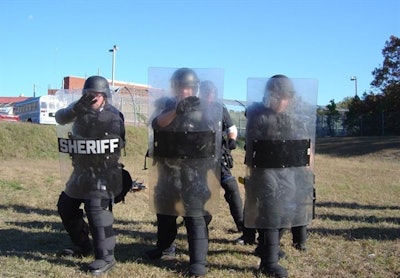 Photo courtesy of Dave Young.
Photo courtesy of Dave Young.
To better understand the progression of thinking and police response in crowd management, let's take a look backward.
1920s Through 1940s
From about 1920 through the 1940s, there was no officially organized or structured response to small or large gatherings and mobs. Standard procedure was a riot line, which was 10 to 20 officers holding batons, axe handles, baseball bats, sticks, or clubs, usually with no other protection. There were usually three to four lines of officers, spaced 20 to 30 feet behind the other. The goal was to push back the crowd of people and/or disperse them. This usually ended up in a free-for-all after the line came into contact with the crowd. The goal of the riot line was to isolate, contain, or overpower the crowd by force. Officer injuries often occurred.
1950s Through Early 1960s
In the late 1950s, the first containment teams and standard squads using riot shields and batons were introduced. The idea was to use the shield squad to push the crowd back and protect the line. When the riot shield squad came into contact with the crowd, the baton squad was right behind it to assist in pushing the crowd back. When the baton and shield squads were confronted with deadly force, there was no preplanned, practiced, or rehearsed response. If deadly force was called for, basically every officer was on his own.
Late 1960s Through 1970s
In this period, CN and CS gas became common in crowd control, and riot squads became more defined.
However, when chemicals were used during a response, many officers were not trained or prepared to operate in a vision-impaired and/or oxygen-depleted environment, or even in how to operate in a protective mask. Officers were trained in control methods, but they were not tactically proficient in these techniques. The gear available to officers did not protect them from common injuries and was generally bulky, so it greatly restricted the officers' movements and was rarely used.
Related:
















